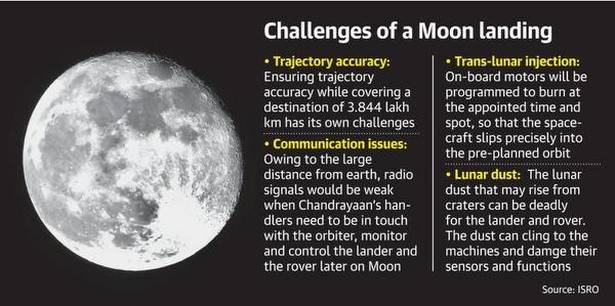Chandrayaan-2 Mission 11/06/2019 – Posted in: Daily News
CHANDRAYAAN-2 MISSION
For: Preliminary & Mains
Topic covers: About Mission, Challenges, Lander and Rover
News Flash
Chandrayaan-2, the country’s first moon lander and rover mission, is a month away.
The Indian Space Research Organisation has marked mid-July for the take-off and kept the launch window open from July 9 to 16.
ISRO has set September 6 as the date to soft-land its landing craft at the lunar south pole – a region where no agency has got to so far.
Chandrayaan-2 will be launched on the heavy-lift GSLV-Mk III rocket.
The Lander and the Rover
The lander is named Vikram (meaning valour, after the father of the Indian space programme, Vikram Sarabhai). It will release a small robotic rover, named Pragyan (wisdom), to move around, feel and understand the lunar surface.
Vikram must gently descend on a harsh rugged lunar surface, without getting damaged. It must also avoid landing in a shadowy patch. It needs sunlight for generating its power.
The orbiter that carries Vikram and Pragyan will go around the moon at a distance of about 100 km, taking pictures and gathering surface information and sending them back to earth.
The moon’s constantly sunny side gets light for 14 Earth days or one lunar day. The lander and the rover are expected to work for just that duration.
Chandrayaan-2 Mission
Chandrayaan-2, India’s second lunar mission, has three modules namely Orbiter, Lander (Vikram) & Rover (Pragyan).
The Orbiter and Lander modules will be interfaced mechanically and stacked together as an integrated module and accommodated inside the GSLV MK-III launch vehicle. The Rover is housed inside the Lander.
After launch into earth bound orbit by GSLV MK-III, the integrated module will reach Moon orbit using Orbiter propulsion module.
Subsequently, Lander will separate from the Orbiter and soft land at the predetermined site close to lunar South Pole.
Further, the Rover will roll out for carrying out scientific experiments on the lunar surface. Instruments are also mounted on Lander and Orbiter for carrying out scientific experiments.
Source: The Hindu
You can follow us on LinkedIn and for more updates related to UPSC IAS Preparation, Like our Facebook Page and subscribe our Diligent IAS Youtube Channel

